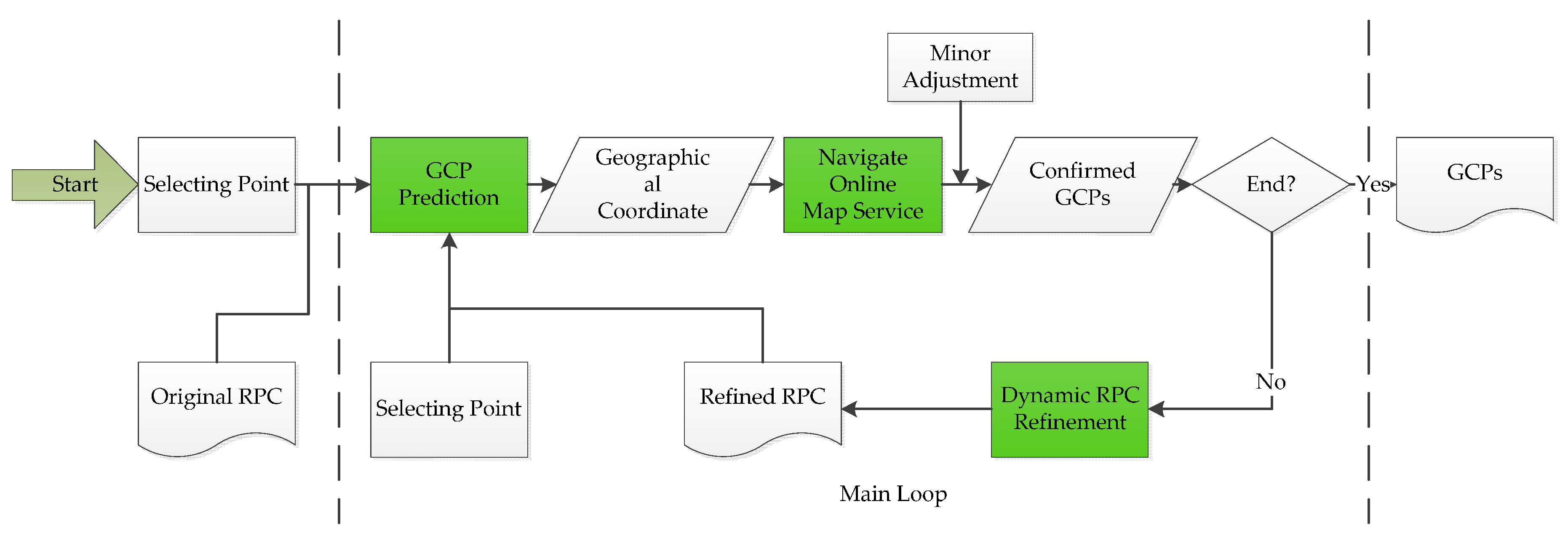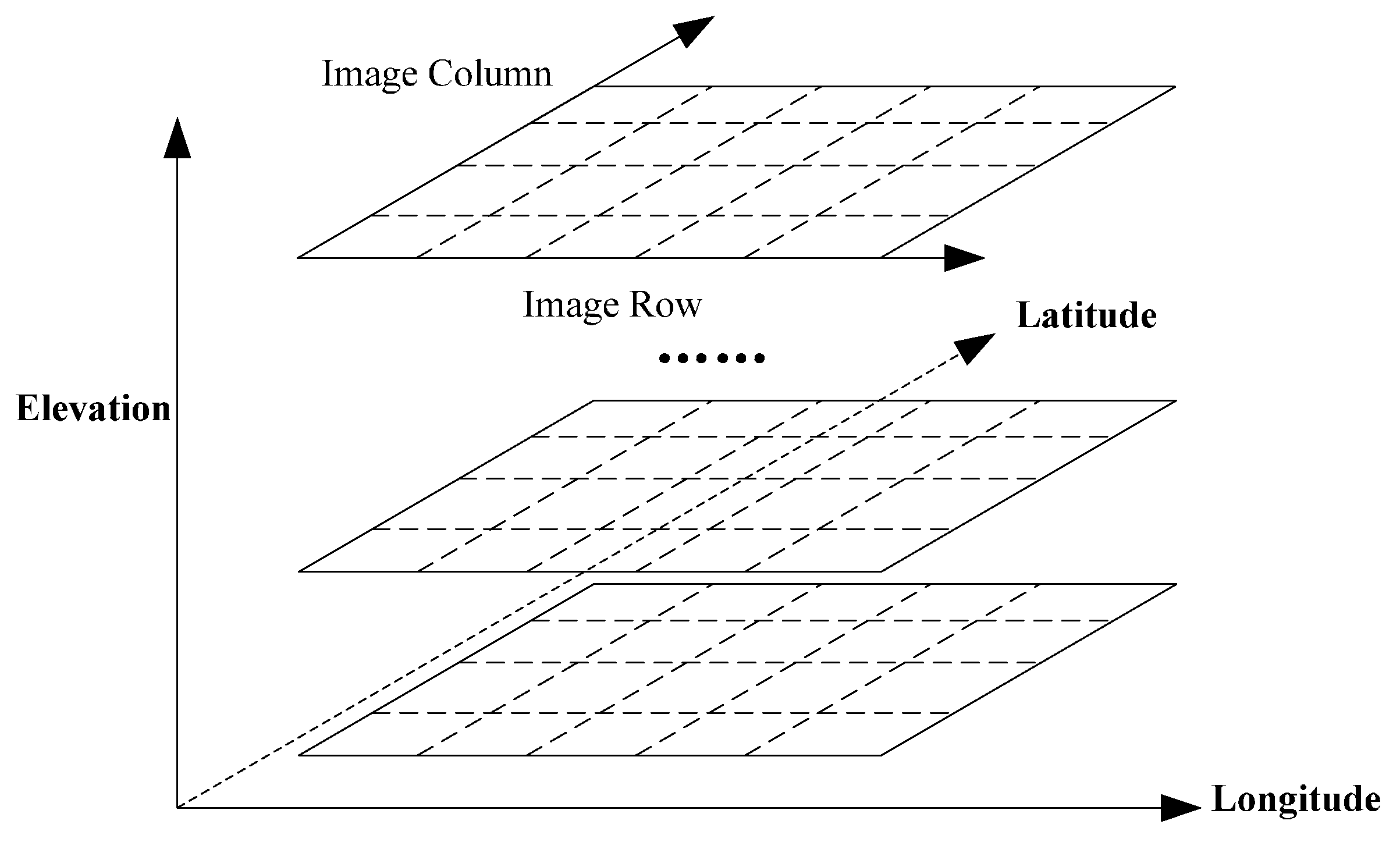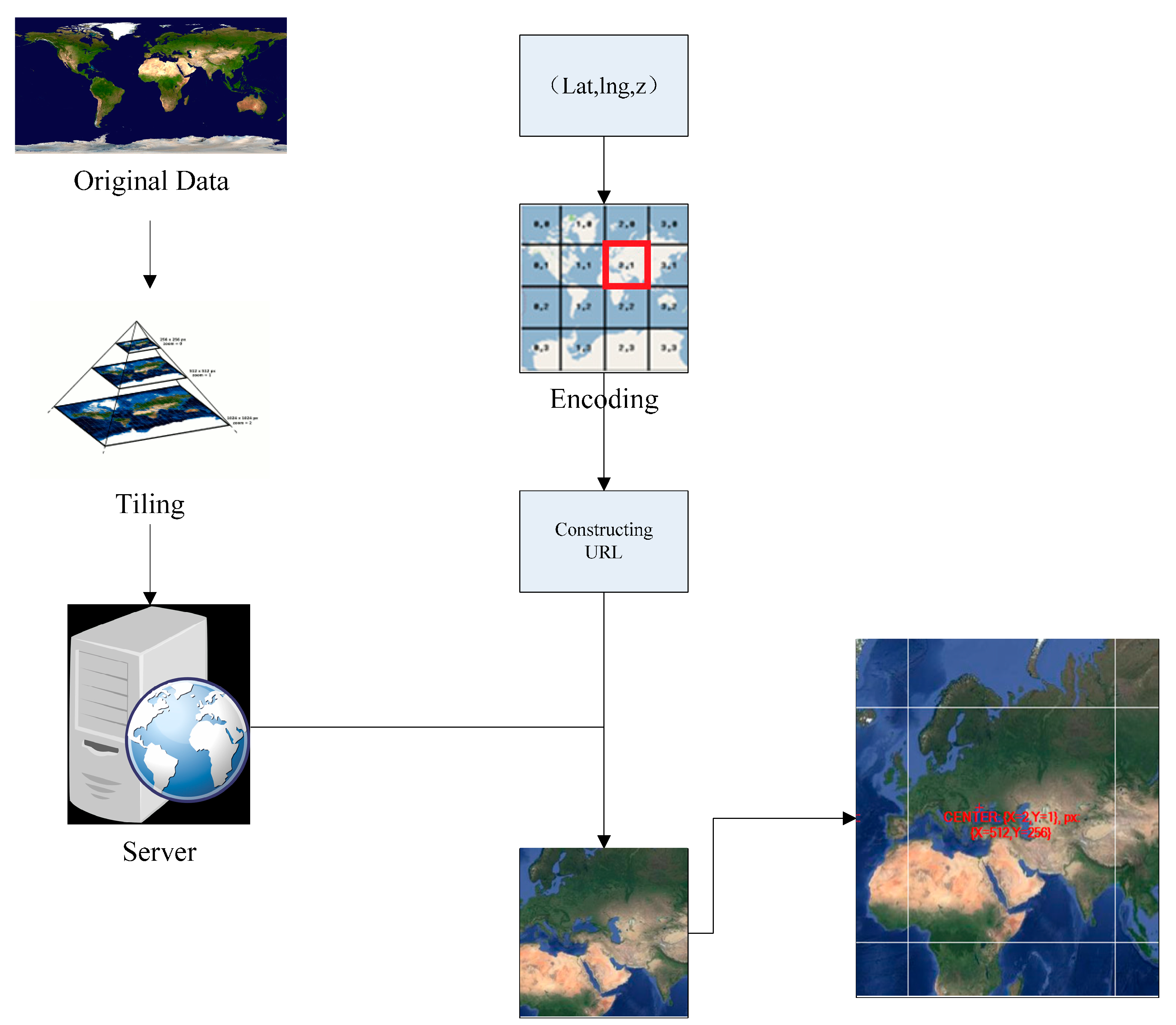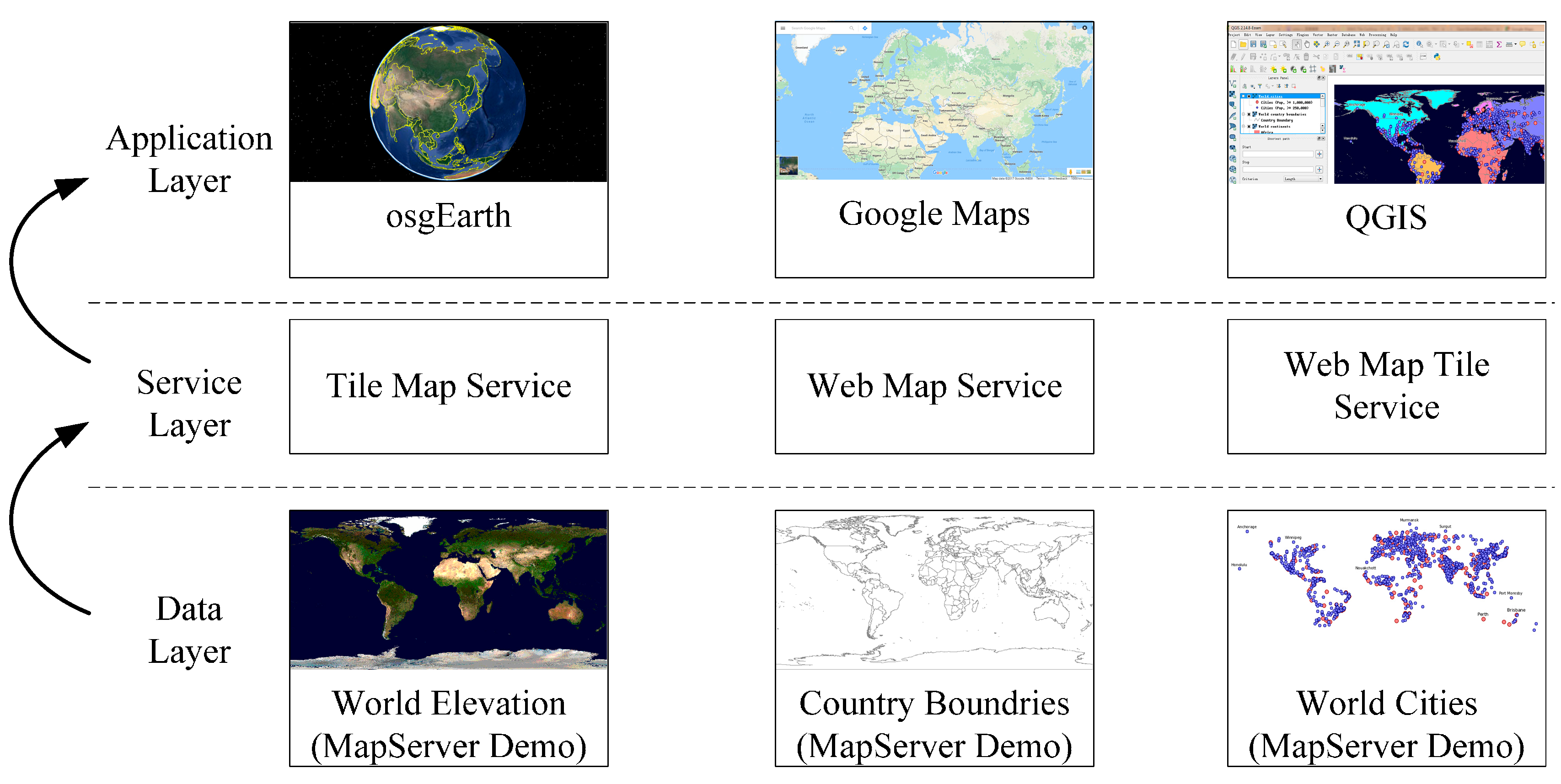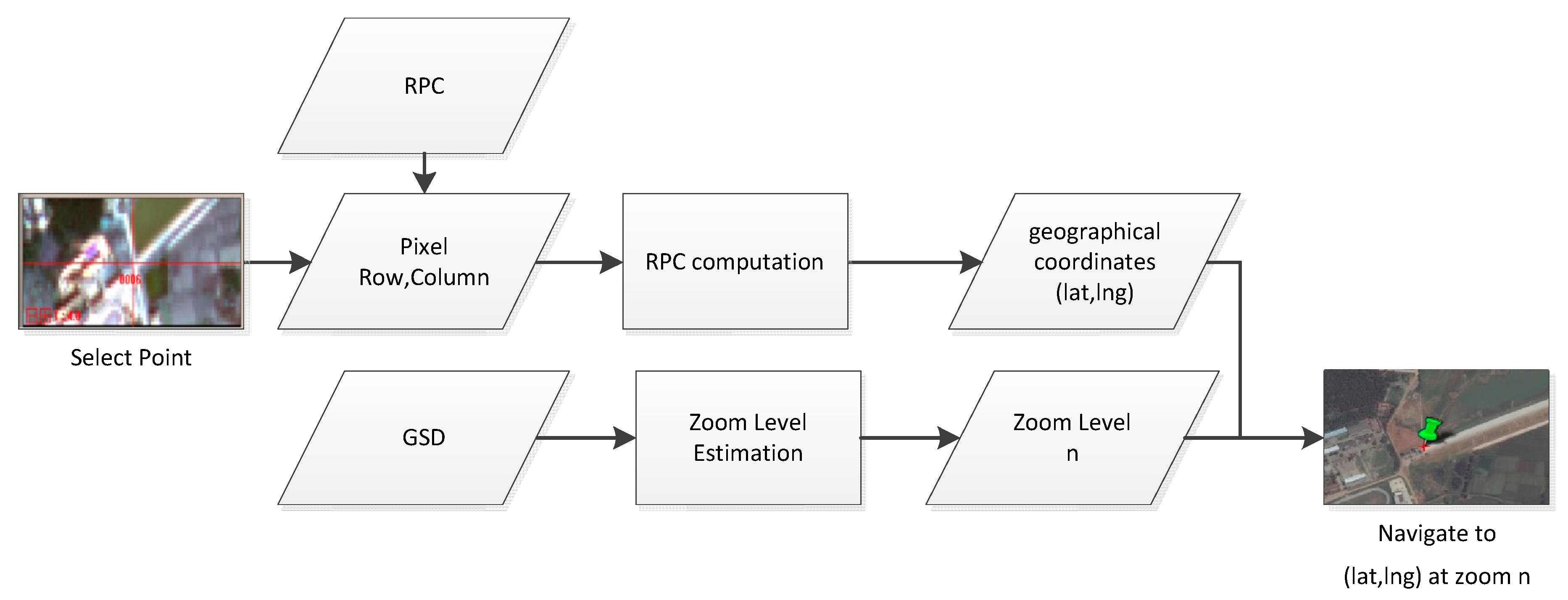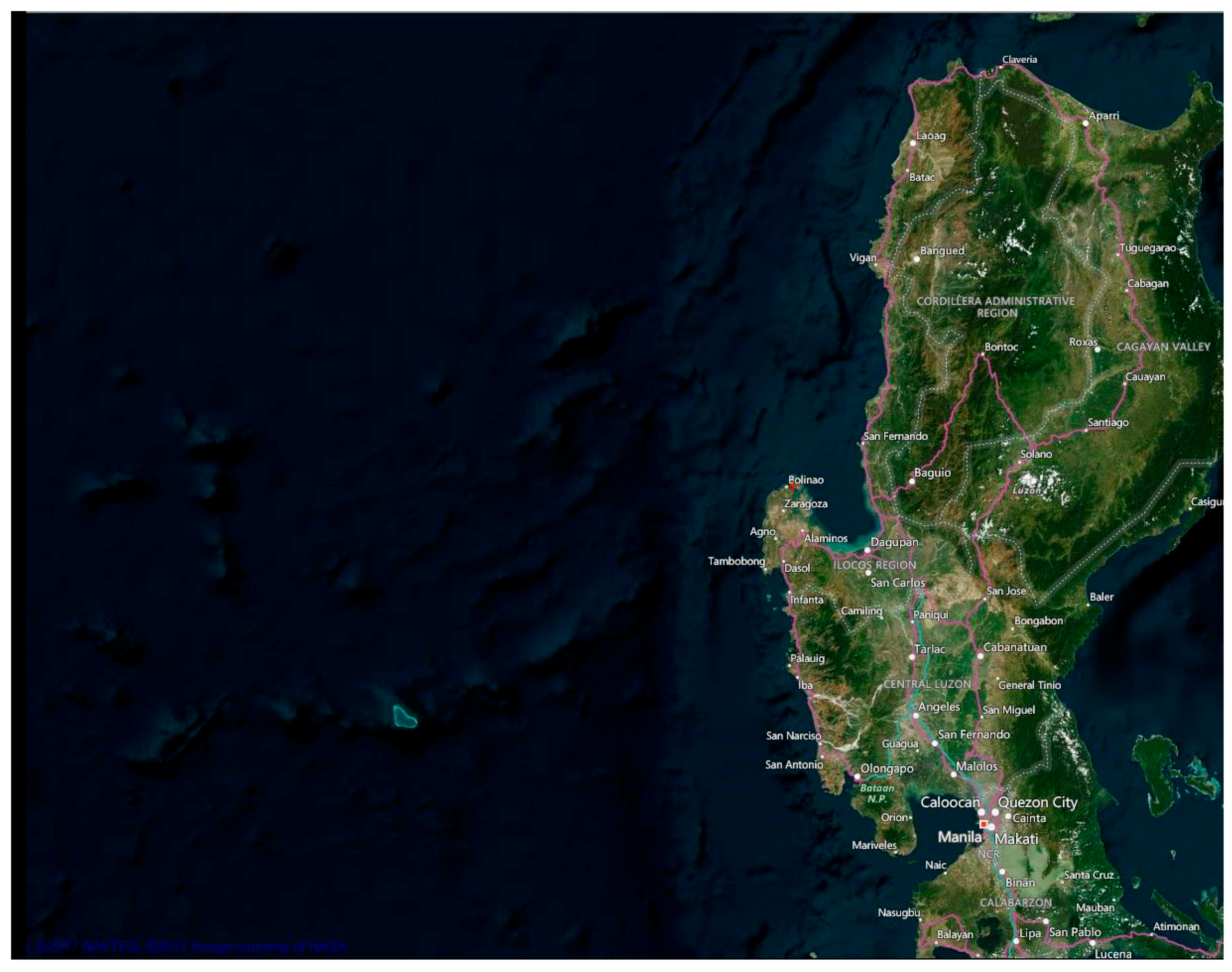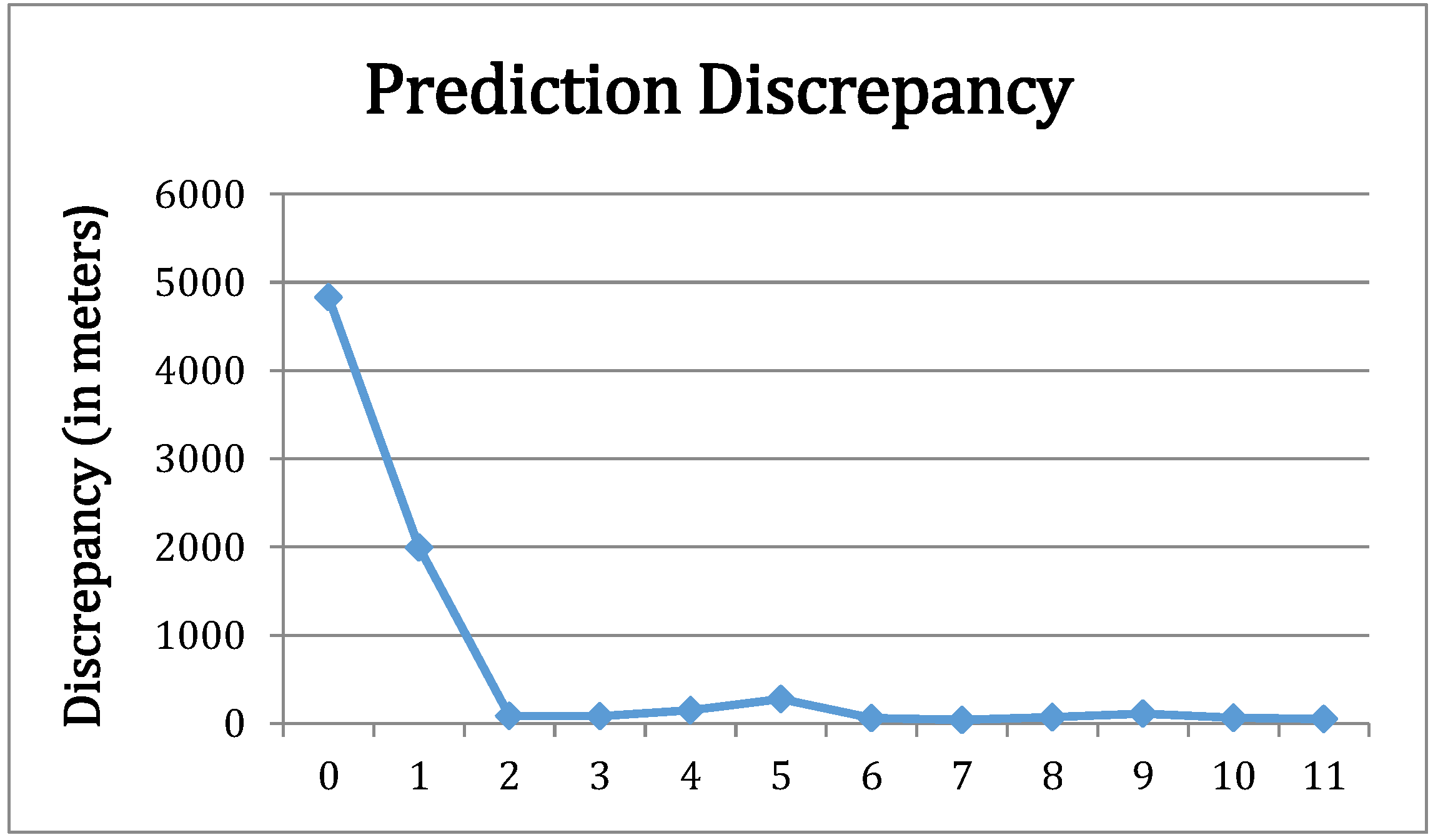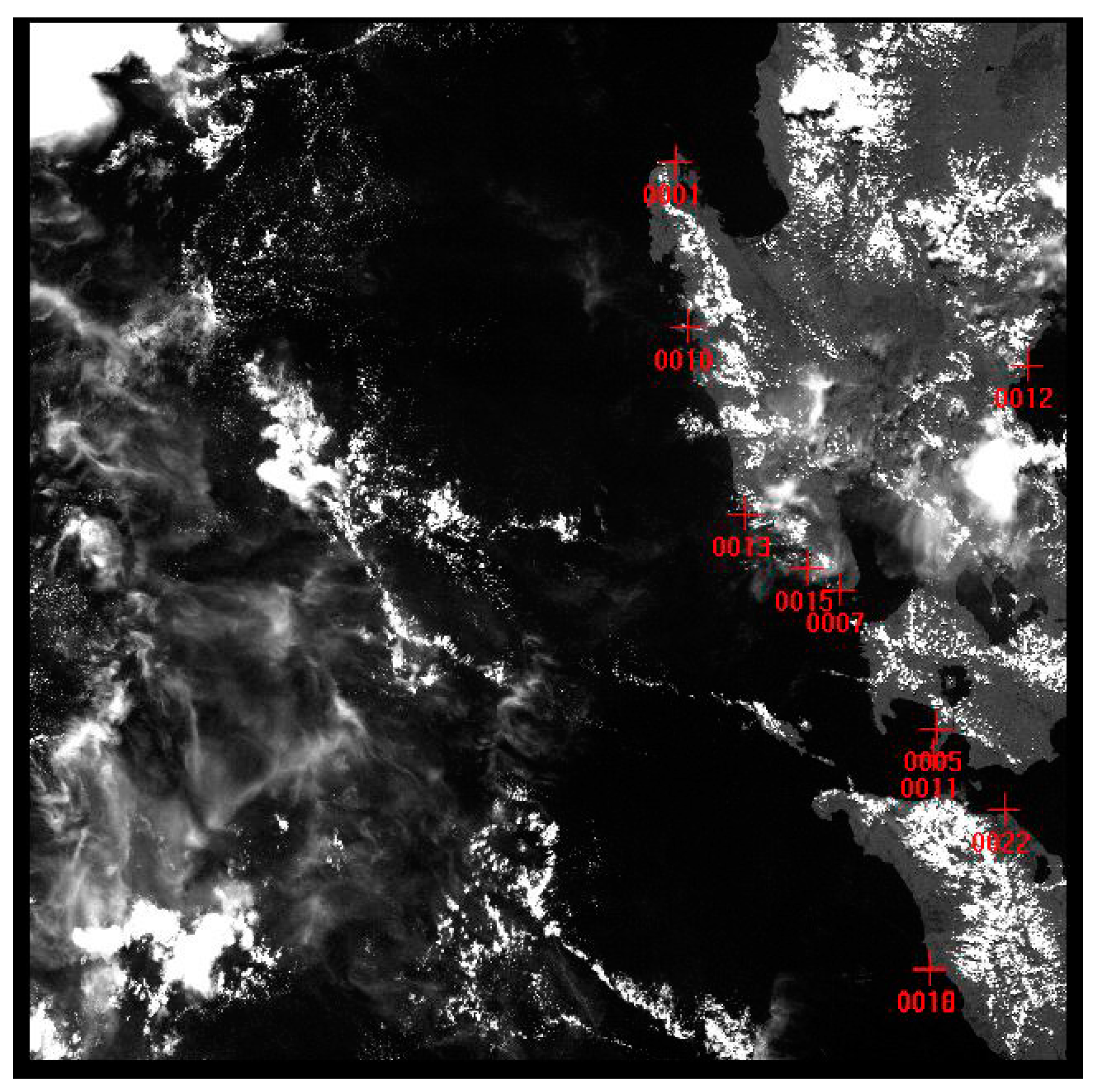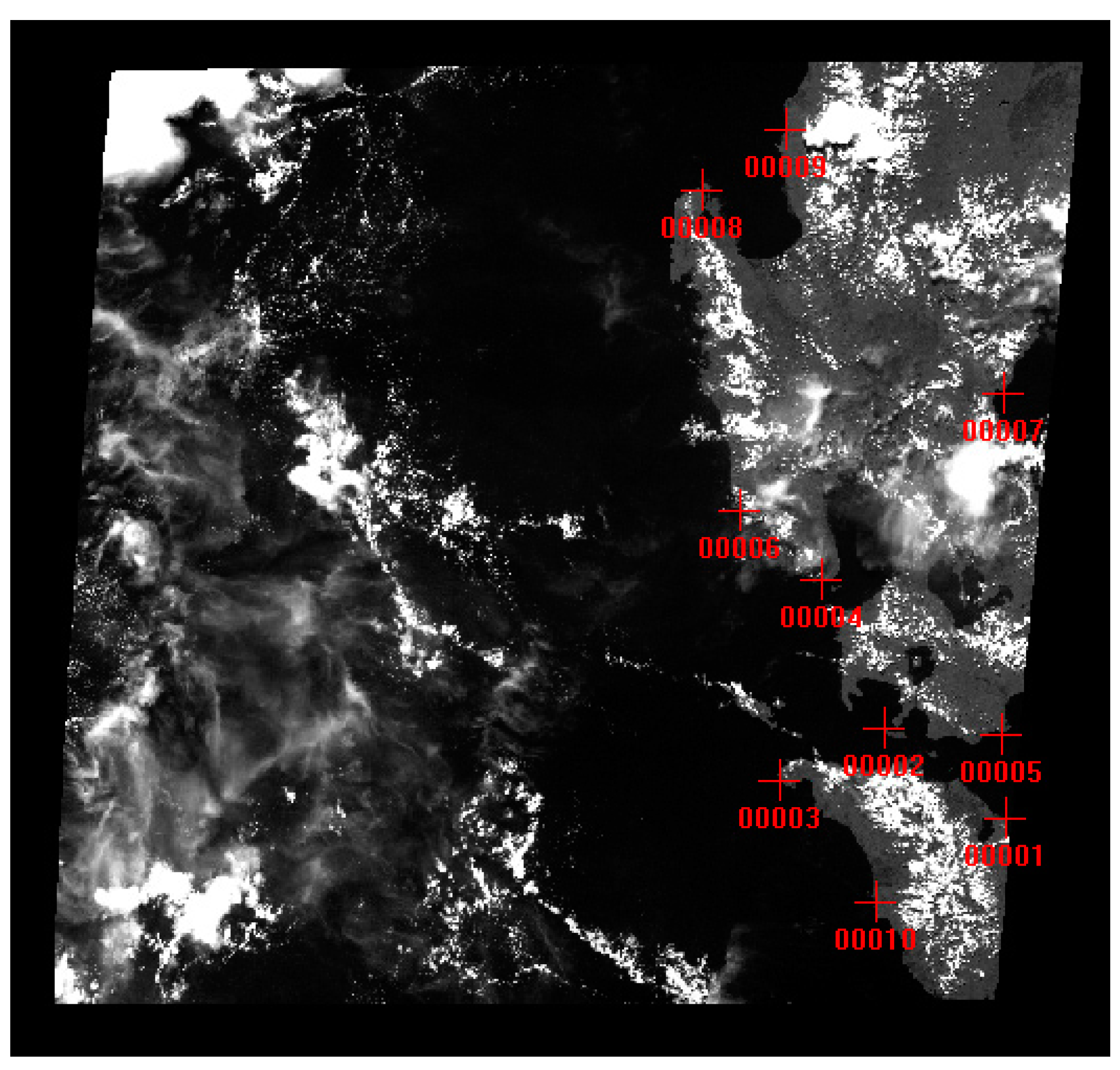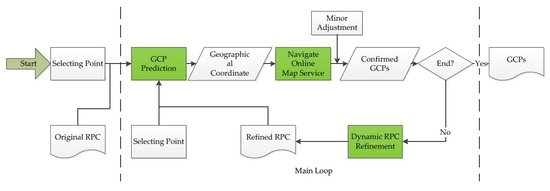1. Introduction
GF-4 (GF is a Chinese abbreviation for high-resolution) is China’s first geostationary earth-observation satellite [
1,
2] enabled with gazing mode, when continuous imagery series of the same area can be captured at intervals of seconds, providing an ideal observation approach for emergency response when facing disasters such as flood. The ground sample distance (GSD) of its panchromatic image is 50 m. However, only poor geometric accuracies (about 4000 m) can be expected from the rational polynomial coefficient (RPC) provided. Even with a GSD of 50 m, its geometric accuracy will not meet the ideal geolocation error requirement of products; for example, Mouillot [
3] carried out an analysis of user needs for burned area (BA) products and pointed out that on average an ideal geolocation accuracy requirement would be 1100 m, with the best GSD (500 m) of the discussed dataset being much lower than GF-4. This geometric accuracy is far from satisfying if emergency decisions are to be made based on the provided coordinates, especially when higher geometric accuracies are required, making ground control points (GCPs) necessary to achieve better accuracies.
The currently available methods of GCP selection can be classified into two categories according to their automation abilities: manual selection methods and methods based on image matching. In manual methods, including field surveying and interpreting existing remote sensing (RS) imagery or GIS data [
4], operators will need to collect the geographic coordinates of certain obvious features that are visible in the imagery. These coordinates may come from existing GCPs, be measured on-site, or be read from existing orthoimages, vectors, or other GIS data. Manually writing down coordinates from online map services is another option, such as the Landsat 8 Ground Control Point Search [
5] tool, which helps select GCPs for Landsat 8 Level 1 data using an online map service provided by Google. A further step is to integrate online map services in currently available tools using extra plugins. In contrast, image matching has been an ideal way to provide GCPs. For example, an automatic method [
6] is proposed to extract GCPs from online map services using Scale-Invariant Feature Transform (SIFT) matching, which is a great trial to combine online map services and image matching technique.
However, neither of these two kinds of methods meets the urgent need of GCP selection for the georeferencing of GF-4 imagery in emergency response. This is mainly because of their poor performance in either efficiency or reliability.
For methods based on image matching, including those that use online map services as reference data, there are several reasons for their poor reliability: (1) generally, GF-4 gives planar array imagery acquired at rather large tilt angles, which means there is obvious geometric distortion between GF-4 imagery and the orthoimagery used as reference data; (2) only very rough coordinates can be derived from original RPC parameters, making it difficult to provide a good estimation for the initial searching area; (3) the imagery is likely to be covering clouds [
7] since a large range of area is covered in a single image.
While for manual selection methods, the low efficiency of the manual selection is a major obstacle: typically, to be georeferenced, operators have to search the GCPs blindly within the whole reference image or the Level 1 imagery, which means substantial amounts of manpower and time are required [
8]. This is mainly because of the lack of GCP prediction, not to mention a prediction that improves as selection goes on, and is also true even when using online map services as reference data.
Last but not least, they share a common major problem, which contributes to their low efficiency as well as poor reliability: the collection of reference data. Finding reference data has always been labor-intensive and may even be impossible to obtain, especially for less developed areas or imagery covering oceans.
On the other hand, with a few confirmed GCPs, the corresponding location on the reference data can actually be predicted for the point/feature that has been selected from the Level 1 image to be georeferenced, even the first GCP can be predicted if there are available RPC parameters for the Level 1 image. What’s more, confirmed GCPs can be used to refine RPC parameters to obtain a better prediction.
As for the reference data, the fast development of Internet and mobile devices has been facilitating the penetration of online map services in daily applications such as path planning and navigation. In this paper, by online map service, we mean a service that provides georeferenced maps, features, vectors, or other geographic information systems (GIS) data through networks and abides by a certain kind of standard. In academic fields, online map services have been widely used in the distribution of GIS data, such as air quality [
9], environmental data [
10], cropland data [
11], and unstable rock slopes [
12], and in the extraction of data on, for example, snow cover time series [
13]. In addition to public online map services, customized ones can be established using your own data, which can be of higher geometric accuracy, with tools such as ArcGIS. Some good trials have been carried out to assist the selection of GCPs using online map services as mentioned before, but they are still far from being satisfactorily explained.
In this paper, a novel emergency georeferencing framework for GF-4 imagery based on RPC refinement and GCP selection assisted by integrated online map services is proposed to solve this problem. The main objective is to provide a fast and reliable GCP selection method for the urgent georeferencing of GF-4 imagery in emergency response. The key feature is dynamic GCP prediction, which is able to predict even the first GCP and the prediction is refined as the selection goes on. This is being done by two techniques: (1) GCP prediction using RPC parameters and (2) dynamic RPC refinement. Additionally, a third technique, the integration of online map services, is adopted to automatically provide reference data, which will save a great deal of time as long as there is Internet access.
This paper is organized as follows:
Section 2 gives detailed information about how to predict and refine RPC when selecting GCPs and the core principles of online map services; experimental verification is presented in
Section 3; a discussion is provided and a brief conclusion drawn in the last two sections, respectively.
3. Results
To validate the proposed framework, a typical scenario was chosen GCPs were selected for a GF-4 Level 1 PAN image. These islands are located in Philippines with an elevation variation from 0 to less than 3000 m. This is a typical area for the proposed framework not because of its elevation variation but because it is very hard for operators to identify features as potential GCPs since (1) the islands only occupy a small portion of the area covered, (2) the islands are surrounded by oceans, and (3) parts of them are covered by clouds in the image.
First of all, the Level 1 data was georeferenced using only its original RPC parameters to evaluate its geometry accuracy, using checkpoints selected from the online map service. GCPs were then selected using the proposed framework. After that, the original image was georeferenced using the selected GCPs. At last, the accuracies of the two georeferenced results were compared.
The online map service used was a hybrid map provided by Bing for both checkpoints’ selection and GCP selection. The ground range of the GF-4 image is shown in
Table 1.
An overview of the range shows that most of the area is covered by ocean, with a smaller part being islands, as is shown in
Figure 7.
3.1. GCP Prediction
The GCP prediction result for the first GCP is shown in
Figure 8, where the right part is GF-4 Level 1 data (wrap image), with a detail window and global window under the main window, and on the left, an online map service (reference image). Within a rather large ground range (we can say a worldwide range), the GCP was successfully predicted and the zoom level estimated. Note that this was the first GCP, meaning there were no other GCPs available for other possible GCP prediction methods. It is obvious that the framework proposed was able to give a rather good estimation of the zoom level as well as the location even for the first GCP.
3.2. Dynamic RPC Refinement
Detail windows of the wrap image and reference image show a rather large discrepancy (actually, the distance is about 4 km) between the predicted location and its true location, which is shown in
Figure 9. By prediction discrepancy, we mean the distance between the predicted point and its true location. To better show the prediction discrepancy, the predicted location (the red cross in the left view) was also manually drawn in the right view (the yellow cross), thus the distance between the yellow cross and the middle of the right view (the center of the big red cross) would be the prediction discrepancy, which is represented by a green line.
Since dynamic RPC refinement was adopted, prediction discrepancy does not remain the same throughout the selecting process. To validate the dynamic RPC refinement, all discrepancies for each GCP selected were logged, as is shown in
Table 2.
The trend line of the prediction discrepancy is shown in
Figure 10.
The prediction discrepancy was 4829 m for the first GCP and decreased to 1994 m for the second GCP since the former GCP was available for RPC refinement. When RPC was refined using the confirmed two GCPs, the prediction discrepancy for the 3rd GCP turned to 84 m, and remained within [40, 276] for the following GCPs, with most of them smaller than 100 m (about 2 pixels). This means, given GCPs, dynamic RPC refinement will help carry out stable and precise predictions.
Prediction discrepancies became stable after only two GCPs (except for the minor ascending trends from three to five GCPs and from 8 to 9 GCPs) because the image space adjustment model adopted changes as the number of GCPs changed, as described in
Section 2.1.2. Given three or more, the type of the model used will be fixed, and new GCPs only bring updates to the coefficients of the model. In fact, the difference in the model used for two GCPs and that used for three GCPs is so small that two GCPs will suffice to stabilize a prediction. Thus, with one GCP, it is difficult to simulate a higher order distribution of prediction discrepancy, and the prediction discrepancy will not remain stable for the first two GCPs. In fact, if the second GCP falls near the 1st GCP, the prediction discrepancy will be almost 0 m. In contrast, if it falls far from the 1st GCP, the discrepancy will increase. With three or more GCPs available for RPC refinement, a 1st order polynomial transformation model can be established to better fit the global distribution of the offsets, which means the following prediction discrepancies will be relatively stable compared with the previous ones.
However, there was a minor ascending trend from three to five GCPs. The reason for the trend is that, when there were three or more GCPs, a 1st order polynomial transformation model was adopted; however, three or four GCPs were not enough to cover the whole image area. Therefore, when a new GCP was selected in an uncovered area, the discrepancy would likely increase since the model was subjected to a rather large update. This also explains the slight increase when the 9th GCP was selected, which was also located in an uncovered area. In conclusion, the limited number of GCPs and their distribution are responsible for the ascending trend from three to five GCPs.
After that, six or more GCPs were enough to maintain a good distribution along the entire image area, and the model was finally stabilized, which shows that, with as few as six GCPs, the proposed framework would be able to give steady and precise GCP predictions.
The combination of GCP prediction and dynamic RPC refinement also saved us a great deal of time. However, it was also not appropriate to carry out a quantitative comparison since the experience of the operator matters here. However, we were still able to draw a qualitative conclusion that these two features did help a great deal, according to our experience of selecting GCPs.
3.3. Georeferencing Accuracy
Eleven GCPs were selected with an RMSE of 12.3 pixels. The 11 GCPs are listed in
Table 3, with
Figure 11 showing the distribution.
With the selected GCPs, we were able to georeference the original image using both the RPC and GCPs to get a Level 2B product. After that, the georeferencing accuracy was checked using 10 checking points, with an RMSE of 86.7 m. The original georeferencing accuracy was also checked, with the RMSE being 3894.4 m. The checking points are listed in
Table 4 and the distribution is shown in
Figure 12. Note that the GCPs and checking points were manually selected in two independent processes: GCP selection and precision checking.
Compared with the original RPC parameters, a new set of RPC parameters given by the proposed framework decreased the RMSE of the georeferencing from 3894.4 (about 78 pixels) to 86.7 m (less than 2 pixels). This was a magnificent improvement and would definitely be quite convenient if it were under emergency response, not to mention the time saved by using GCP prediction, dynamic RPC refinement, and online map services.
Additionally, the RMSE of the selected GCPs was 12.3 pixels (see
Table 3) and about 615 m. However, the accuracy of the final Level 2B product was improved to better than 100 m, which is about 2 pixels. This means that the instability of man-selecting can be compensated by the dynamic RPC refinement to some extent.
4. Discussion
As has been demonstrated in
Section 3, the proposed framework is able to provide GCP prediction throughout the entire selection process, which will greatly improve efficiency. We actually did not carry out any quantitative evaluations about how much time was saved either by using online maps services as reference data or by using the combination of GCP prediction and dynamic RPC refinement to assist GCP selection. However, our experience indicates that, normally, at least 10–20 min will be needed to select GCPs for a GF-4 imagery, while, with the help of the proposed framework, the work can be done within 1 min. Note that there is no need to collect reference images anymore. In fact, the cost of collecting reference images cannot be simply measured by the time spent, the money spent, nor the personnel involved, since, in practice, a failed or even delayed collection of reference data may lead to unimaginable loss. It is also unreasonable to log how long it takes to select GCPs without GCP prediction, because the speed of GCP selection, for the same operator, varies from one operator to another, from one image to another, and even from one time to another. However, we do know that, when using an online map service as a reference image, only Internet access is needed, thus saving time, money, and personnel and even reducing the potential loss of property and human lives.
Aside from the proposed framework, there are also other ways to carry out GCP prediction and to refine the predictions. For example, geographical coordinates can be directly derived from pixel coordinates using a 2nd order polynomial transformation determined by the confirmed GCPs, just like our group has been using for years. However, the major problem lies in the first three GCPs that are needed to determine the transformation: this method is not capable of predicting the first three GCPs. Note that, during manual GCP selection, this is exactly when GCP prediction is most needed, since the first few GCPs are hardest to select, especially when there is a rotation between Level 1 imagery and the reference image or when the area covered is too large.
We may go further based on the proposed framework towards a full ability of automation by introducing an image matching technique. Since no matter how precisely the GCP is predicted, its final confirmation depends on human intervention. In fact, the reliability of the image matching technique will increase if we are able to carry out a good estimation of the potential matching area. This is precisely what we have done here. We carried out trials using SIFT and least squares matching (LSM): once the GCP was predicted, we clipped the image area around the selected point as well as the image area around the predicted point and tried to match them using the mentioned methods. The results were not satisfying, but this still remains a promising direction in which to proceed.
The proposed framework can also be applied to other Level 1 satellite imagery, and its application is not limited to emergency response as long as there are RPC parameters available. In addition, orthoimagery and digital line graphics (DLGs) with low geometric accuracy will also find this framework helpful, with a minor change to the GCP prediction method and the dynamic RPC refinement if needed.
